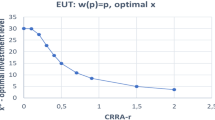Abstract
Investors who are more willing to accept risks when evaluating their investments less frequently are said to exhibit myopic loss aversion (MLA). Several recent experimental studies found that, on average, subjects bet significantly higher amounts on a risky lottery when they observe only a cumulative outcome of several realizations of the lottery (long evaluation period). In this article, we reexamine these empirical findings by analyzing individual rather than aggregate choice patterns. The behavior of the majority of subjects is inconsistent with the hypothesis of MLA: they bet an intermediate fraction of their initial endowment and these bets, on average, are not significantly different across two treatments with short and long evaluation period. We discuss several alternative explanations of this finding, including the Fechner model of random errors and the financial asset pricing model.
Similar content being viewed by others
References
Abdellaoui M. (2000) Parameter-free elicitation of utility and probability weighting functions. Management Science 46(11): 1497–1512
Bellemare Ch., Krause M., Kröger S., Zhang Ch. (2005) Myopic loss aversion: Information feedback vs. investment flexibility. Economics Letters 87: 319–324
Benartzi S., Thaler R. (1995) Myopic loss aversion and the equity premium puzzle. Quarterly Journal of Economics 110(1): 73–95
Bhushan R., Brown D., Mello A. (1997) Do noise traders ‘create their own space?’. Journal of Financial and Quantitative Analysis 32(1): 25–45
Blavatskyy P. (2008) Stochastic utility theorem. Journal of Mathematical Economics 44: 1049–1056
Blavatskyy, P. R., & Köhler, W. R. (2009). Range effects and lottery pricing. Experimental Economics. doi:10.1007/s10683-009-9215-y.
Coval J.D., Shumway T. (2005) Do behavioral biases affect prices?. Journal of Finance 60(1): 1–34
Durand R., Lloyd P., Wee Tee H. (2004) Myopic loss aversion and the equity premium puzzle reconsidered. Finance Research Letters 1: 171–177
Fechner G. (1860) Elements of psychophysics. Holt, Rinehart and Winston, NewYork
Fielding D., Stracca L. (2006) Myopic loss aversion, disappointment aversion and the equity premium puzzle. Journal of Economic Behavior and Organization 64(2): 250–268
Gneezy U., Potters J. (1997) An experiment on risk taking and evaluation periods. Quarterly Journal of Economics 112(2): 631–645
Gneezy U., Kapteyn A., Potters J. (2003) Evaluation periods and asset prices in a market experiment. Journal of Finance 58(2): 821–838
Haigh M., List J. (2005) Do professional traders exhibit myopic loss aversion?. An experimental analysis. Journal of Finance 60(1): 523–534
Hey J. (2001) Does repetition improve consistency?. Experimental Economics 4: 5–54
Kelly M. (1997) Do noise traders influence stock prices?. Journal of Money, Credit and Banking 29(3): 351–363
Köbberling V., Wakker P. (2005) An index of loss aversion. Journal of Economic Theory 122(1): 119–131
Langer Th., Weber M. (2005) Myopic prospect theory vs. myopic loss aversion: How general is the phenomenon?. Journal of Economic Behavior and Organization 56(1): 25–38
Mehra R., Prescott E. (1985) The equity premium: A puzzle. Journal of Monetary Economics 15(2): 341–350
Odean T. (1998) Volume, volatility, price and profit when all traders are above average. Journal of Finance 53(6): 1887–1934
Plott Ch., Zeiler K. (2005) The willingness to pay—willingness to accept gap, the “endowment effect,” subject misconceptions, and experimental procedures for eliciting valuations. American Economic Review 95(3): 530–545
Plott Ch., Zeiler K. (2007) Asymmetries in exchange behavior incorrectly interpreted as evidence of prospect theory. American Economic Review 97(4): 1449–1466
Thaler R., Tversky A., Kahneman D., Schwartz A. (1997) The effect of myopia and loss aversion on risk taking: An experimental test. Quarterly Journal of Economics 112(2): 647–661
Tversky A., Kahneman D. (1992) Advances in prospect theory: Cumulative representation of uncertainty. Journal of Risk and Uncertainty 5(4): 297–323
Author information
Authors and Affiliations
Corresponding author
Rights and permissions
About this article
Cite this article
Blavatskyy, P.R., Pogrebna, G. Reevaluating evidence on myopic loss aversion: aggregate patterns versus individual choices. Theory Decis 68, 159–171 (2010). https://doi.org/10.1007/s11238-009-9143-5
Received:
Accepted:
Published:
Issue Date:
DOI: https://doi.org/10.1007/s11238-009-9143-5




